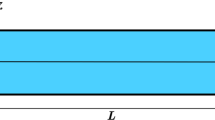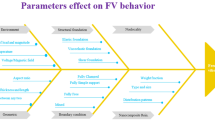Abstract
Analyzing the dynamic response of electrostatic devices is problematic due to the complexity of the interactions between the electrostatic coupling effect, the fringing field effect and the nonlinear electrostatic force. To resolve this problem, this study presents an efficient computational scheme in which the nonlinear governing equation of the electrostatic device is obtained in accordance with Hamilton’s principle and is then solved using a hybrid differential transformation/finite difference method. The feasibility of the proposed approach is demonstrated by modeling the dynamic responses of two micro fixed-fixed beams with lengths of 250 and 350 μm, respectively. The numerical results show that the pull-in voltage reduces as the beam length increases due to a loss in the structural rigidity. Furthermore, it is shown that the present results for the pull-in voltage deviate by no more than 0.75% from those derived in the literature using a variety of different schemes. Overall, the results presented in this study demonstrate that the proposed hybrid method represents a computationally efficient and precise means of obtaining detailed insights into the nonlinear dynamic behavior of micro fixed-fixed beams and similar micro-electro-mechanical systems (MEMS)-based devices.







Similar content being viewed by others
References
Chan EK, Garikipati K, Dutton RW (1999) Characterization of contact electromechanics through capacitance-voltage measurements and simulations. J Microelectromech Syst 8(2):208–217. doi:10.1109/84.767117
Chen CK, Ho SH (1996) Application of differential transformation to eigenvalue problem. Appl Math Comput 79:173–188. doi:10.1016/0096-3003(95)00253-7
Chen CK, Ho SH (1998) Free vibration analysis of non-uniform timoshenko beams using differential transform. Appl Math Model 22(4–5):219–234. doi:10.1016/S0307-904X(98)10002-1
Chen CL, Liu YC (1998) Solution of two-boundary-value problems using the differential transformation method. J Optim Theory Appl 99:23–35
Chiou JS, Tzeng JR (1996) Application of the Taylor transform to nonlinear vibration problems. Trans ASME J Vib Acoust 118:83–87
Chowdhury S, Ahmadi M, Miller WC (2005) A comparison of pull-in voltage calculation methods for MEMS-based electrostatic actuator design. In: 1st international conference on sensing technology, November 21–23, Palmerston North, New Zealand
Gretillat MA, Yang YJ, Hung ES, Rabinvich V, Ananthasuresh GK, Rooij NF, Senturia SD (1997) Nonlinear electromechanical behavior of an electrostatic microrelay. In: Proceedings of the international conference on solid-state and actuators (Transducers ‘97). IEEE, Chicago, IL, pp 1141–1144
Hu YC, Chang CM, Huang SC (2004) Some design considerations on the electrostatically actuated microstructures. Sens Actuators A 112:155–161. doi:10.1016/j.sna.2003.12.012
Hu M, Du H, Ling S, Liu B, Lau G (2005) Fabrication of a rotary micromirror for fiber-optic switching. Microsyst Technol 11:987–990. doi:10.1007/s00542-005-0504-x
Hung ES, Senturia SD (1999) Extending the travel range of analog-tuned electrostatic actuators. J Microelectromech Syst 8(4):497–505. doi:10.1109/84.809065
Kuang JH, Chen CJ (2005) Adomian decomposition method used for solving nonlinear pull-in behavior in electrostatic micro-actuators. Math Comput Model 41:1478–1491. doi:10.1016/j.mcm.2005.06.001
Kuo BL, Chen CK (2003) Application of the hybrid method to the solution of the nonlinear burgers’ equation. ASME J Appl Mech 70:926–929. doi:10.1115/1.1629107
Luharuka R, LeBlanc S, Bintoro JS, Berthelot YH, Hesketh PJ (2008) Simulated and experimental dynamic response characterization of an electromagnetic microvalve. Sens Actuators A 143:399–408. doi:10.1016/j.sna.2007.10.084
Maluf NI, Kovacs GTA, Reay RJ (1996) High-voltage devices and circuits fabricated using foundry CMOS for use with electrostatic MEM actuators. Sens Actuators A 52:187–192
Osterberg PM, Senturia SD (1997) M-test: a test chip for MEMS material property measurement using electrostatically actuated test structures. J Microelectromech Syst 6(2):107–118. doi:10.1109/84.585788
Osterberg P, Yie H, Cai X, White J, Senturia S (1994) Self-consistent simulation and modeling of electrostatically deformed diaphragms. IEEE MEMS’94 Workshop. Oiso Jpn 25–28 (January), pp 28–32
Rezazadeh G, Tahmasebi A, Zubstov M (2006) Application of piezoelectric layers in electrostatic MEM actuators: controlling of pull-in voltage. Microsyst Technol 12:1163–1170. doi:10.1007/s00542-006-0245-5
Son IS, Lal A, Hubbard B, Olsen T (2001) A multifunctional silicon-based microscale surgical system. Sens Actuators A 91:351–356
Timoshenko S (1987) Theory of plates and shells, vol 118, no 125. McGraw-Hill, New York, pp 4–6
Wang QX, Li H, Lam KY (2007) Analysis of microelectromechanical systems (MEMS) devices by the meshless point weighted least-squares method. Comput Mech 40:1–11. doi:10.1007/s00466-006-0077-2
Wong J-E Lang JH, Schmictt MA (2000) An electrostatically-actuated MEMS switch for power applications. In: Proceedings of the IEEE MEMS 2000 Conference, Miyazaki, Japan, 23–27 January 2000, pp 633–638
Yu LT, Chen CK (1998) The solution of the Blasius equation by the differential transformation method. Math Comput Model 28:101–111
Yu LT, Chen CK (1999) Application of the hybrid method to the transient thermal stresses response in isotropic annular fins. ASME J Appl Mech 66:340–346
Zhou X (1986) Differential transformation and its applications for electrical circuits. Huazhong University Press, Wuhan in Chinese
Author information
Authors and Affiliations
Corresponding author
Rights and permissions
About this article
Cite this article
Chen, CK., Lai, H.Y. & Liu, CC. Application of hybrid differential transformation/finite difference method to nonlinear analysis of micro fixed-fixed beam. Microsyst Technol 15, 813–820 (2009). https://doi.org/10.1007/s00542-009-0834-1
Received:
Accepted:
Published:
Issue Date:
DOI: https://doi.org/10.1007/s00542-009-0834-1




